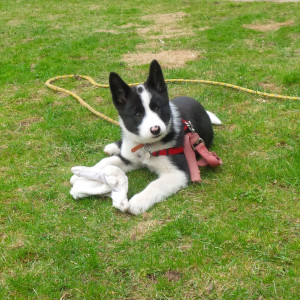
When preparing for a new puppy, I was excited to meet my new pal, but after thinking about all of the ways I needed to make my home puppy proof I was also scared! Our first dog, Misha, was between 2 and 3 years old when we adopted her, which means that we skipped a lot of the early challenges, like chewing and potty training with a tiny bladder (Misha was not house trained: her adult-sized bladder was an asset in some ways and a curse in another!).
So, armed with a list of recommendations from my breeder and the internet, here are my top recommendations to puppy proof your home:
1. Investigate your home from the puppy point of view
How often do you crawl around your living room? Until you have someone small running around – be it dog, cat or child – it’s hard to realize exactly how many tempting items are close to the ground.
Get down low, put on your Safety Sam hat, and start looking around. How many breakable, chewable, or dangerous things can you find?
Here’s what I found in my living room:
- A pile of throw cushions in the corner. Feather stuffing, of course. Looks good to chew on!
- Cords. Lots and lots of electrical cords for lamps, the TV, the stereo.
- Remotes, coasters, and some easily-stolen nicknacks.
- A small waste basket.
None of these things interest the resident cats or my adult dog, but I bet the puppy will be neck deep in trouble in minutes!
When I continued my low-angle inspection in the rest of my house, I found things like:
- A random sock that missed the laundry hamper (I wondered where that went!).
- Cleaning supplies tucked behind the toilet.
- Shampoo and other bath accessories on the edge of the tub.
- More waste baskets without lids.
- Cat toys.
- A pile of clothes for the donation box.
- Cables, cables, and more cables.
So, other than learning that we’re slobs, I’ve gotten the idea that my house is NOT PUPPY PROOF.
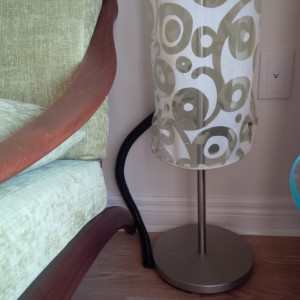
2. Puppy proof your cables
Electronics and appliances are a pretty big part of our lives and there are cables everywhere. The visual clutter has always bothered me, but now I have to worry about tiny teeth too!
There are lots of solutions for protecting your cables from a puppy, but the easiest and cheapest way I found was split-loom tubing. I found some in the automotive section at Canadian Tire, but you should be able to find it at almost any hardware store. I’m sure some enterprising person has introduced split-loom tubing in decor-pleasing colours, but Canadian tire had basic black.
The result is a little on the sci-fi side, but it works.
3. Move it or lose it!
When I was a kid, we had a neurotic Siamese cat who ate sweaters. He was a model citizen in all other ways, but he just could not help himself when it came to chewing on wool. We learned early on to put it away if we didn’t want to lose it.
Clearly this rule is going to have to come back into effect. If it’s within a puppy’s reach, it’s fair game for him to take. Sure, there are all sorts of learning opportunities here for puppy to learn what he can have and what he can’t, but those opportunities only exist when you are paying attention and can redirect the puppy immediately.
I have no doubt that there will be forgetful moments and destroyed stuff along the way, but for now, I’m puppy proofing by moving everything tempting to safer locations.
A sick part of me hopes that the puppy is really destructive and trains us to be tidier. Every good relationship has give and take, right?
4. Create puppy-safe zones
When you are focusing directly on your puppy, the house is a safe zone. But what about when you’re cooking dinner, on an important phone call, or even making a quick trip to the washroom? When your attention wanders and the puppy has a few minutes to himself, it’s best for the puppy to be in an area that is 100% puppy proof.
In our case, there are a few puppy-safe zones:
- The office – we work at home and spend most of the day in the office. Thanks to a baby gate and making sure all of our computer cords are puppy proof, the office is a good place for him to be without direct supervision if we have to step out of the room.
- The kitchen – again, thanks to the magic of baby gates and closed doors, the kitchen is a durable place with all of the interesting things out of reach or behind doors. If the puppy is strong and smart enough to figure out how to open cupboard doors, we can add childproofing latches to keep them shut (one of the cats has worked out cupboard doors, but the doors in our current home are too heavy for her, so I’m hoping the same is true for the puppy).
- The main living area – open concept is great, until you try to keep a small, active creature in view! If we close the bedroom, bathroom, and office doors, the puppy has a big area to roam in that is mostly visible from any spot in the room.
5. Create puppy-dedicated zones
We have a small home and a plan for giving the puppy freedom in a safe way, but what about puppy proofing strategies for people with larger homes and complicated floor plans? Or when something busy and dangerous is happening? Sometimes closing a few doors isn’t going to be enough.
This is where dog pens (also known as a puppy play pen) and dog crates come into play.
Puppy play pens are completely portable and allow you to created a fenced in area where ever you need it in your home.
A dog crate is a dog’s personal safe zone. Crate training allows the dog to have a restricted, safe place to retreat to – just to hang out, take a nap, or when you need them to be contained and safe.
For much more detail about using dog pens and dog crates, see Liz’s Dog Crate Training Tips.
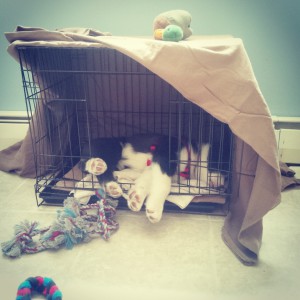
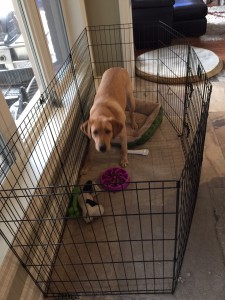
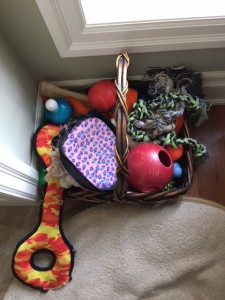
6. Make the puppy’s stuff visible and accessible
Just like a dog crate will be a safe zone the puppy will learn is his, making sure he understands what items in the home are his for chewing and playing with is a good idea.
We’re setting up a toy box just for the puppy, filled with tempting things for him to play with. The idea here is that whatever is in that box is 100% ok for the puppy to play with – stuff that is just laying around isn’t.
What are your tips for making your home puppy proof? What do you know now that you wish you’d known before you brought your puppy home? Share your ideas in the comments below!


